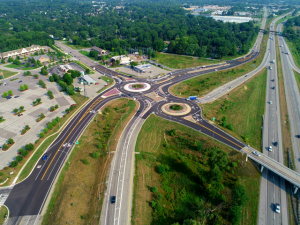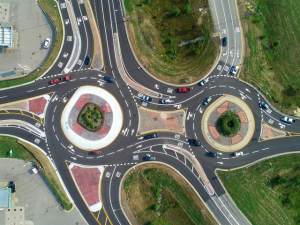Livingston County Road Commission
It all began around 1905…
Traffic circles have been part of the transportation system in the United States since 1905, when the Columbus Circle designed by William Phelps Eno opened in New York City. Subsequently, many large circles or rotaries were built in the United States. The prevailing designs enabled high-speed merging and weaving of vehicles. Priority was given to entering vehicles, facilitating high-speed entries. High crash experience and congestion in the circles led to rotaries falling out of favor in America after the mid-1950’s. Internationally, the experience with traffic circles was equally negative, with many countries experiencing circles that locked up as traffic volumes increased.
Changes in the United Kingdom created the modern roundabout…
The modern roundabout was developed in the United Kingdom to rectify problems associated with these traffic circles. In 1966, the United Kingdom adopted a mandatory “give-way” rule at all circular intersections, which required entering traffic to give way, or yield, to circulating traffic. This rule prevented circular intersections from locking up, by not allowing vehicles to enter the intersection until there were sufficient gaps in circulating traffic. In addition, smaller circular intersections were proposed that required adequate horizontal curvature of vehicle paths to achieve slower entry and circulating speeds.
Modern roundabouts have improved traffic safety and traffic operations over older circles…
These changes improved the safety characteristics of the circular intersections by reducing the number and particularly the severity of collisions. Thus, the resultant modern roundabout is significantly different from the older traffic circle both in how it operates and in how it is designed. The modern roundabout represents a substantial improvement, in terms of operations and safety, when compared with older rotaries and traffic circles. Therefore, many countries have adopted them as a common intersection form and some have developed extensive design guides and methods to evaluate the operational performance of modern roundabouts.
Simply stated, a modern roundabout is a transportation management tool that moves traffic through an intersection without the aid of traffic signals. More specifically, a modern roundabout is an intersection with one-way circulation around a central island where entering traffic must yield the right-of-way to the traffic circulating within the roundabout.
A modern Roundabout should not be confused with traffic rotaries or circles, which are much larger, with higher speeds and multiple lanes for entering and exiting. As traffic volumes increase, collisions and traffic jams can occur because vehicles are not required to yield to traffic before entering.
Traffic engineers recognized the deficiencies associated with traffic rotaries and circles, and incorporated slower speeds and “yield on entry” into modern roundabouts.

Engineering analyses have determined that roundabouts can perform more effectively than traditional signals at many intersections.
Although roundabouts are not appropriate for all intersections, they do provide our community with another tool to address traffic congestion and to further enhance the safety of our roadways.
When designed correctly modern roundabouts can significantly reduce the amount of pollutants released into the atmosphere from idling vehicles when compared to other intersections. At signalized intersection locations, where actuated signals are not present, many drivers must wait up to 20 seconds or longer for the light to turn green, even during off-peak hours when no crossroad or opposing traffic is present on other approaches. Since the entry control at modern roundabouts utilizes the “yield to left” principle, drivers spend less time idling their vehicles prior to entering the intersection.

A modern roundabout is a circular, unsignalized intersection where entering traffic yields to motorists circulating counterclockwise around a central island. Modern roundabouts are engineered to maximize safety and reduce overall delay at an intersection.
 | Safety Roundabouts have been shown to reduce fatal and injury accidents by as much as 76% in the United States. Slower speed and the reduced number of conflict numbers are attributed to the reduction in accidents. |
 | Calming Effects Roundabouts can serve to decrease aggressive driving, the roundabouts provide no red light to try to “beat,” or opportunity to race away from the stop line after the signal finally turns green. |
 | Low Maintenance Eliminated maintenance costs associated with traffic signals. |
 | Reduced Delay By yielding at the entry rather than stopping and waiting for a green light, delay is significantly reduced. |
 | Capacity Intersections with a high volume of left turns are better handled by a roundabout than a multi-phased traffic signal. |
 | Aesthetic A reduction in delay corresponds to a decrease in fuel consumption and air pollution. In addition, the central island provides an opportunity to provide landscaping. |
Sometimes everything you read or hear is not necessarily true. The following documents (Courtesy of APA, DLZ Michigan, Inc. and Washtenaw County Road Commission) are intended to help educate readers on the facts of modern roundabouts.
Common Misperceptions about Modern Roundabouts
(Courtesy of APA and SLZ Michigan, Inc.)